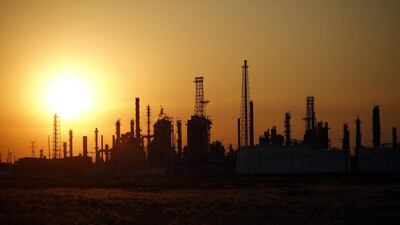Oil markets have been sanguine about geopolitical risk in recent years.
At the peak of oil prices in 2008, observers ascribed as much as US$10 to $15 per barrel of the price to a “risk premium”. Now, with Iraqi troops advancing on Kirkuk and the US president Donald Trump ceasing to certify the Iran nuclear deal, is it time for the risk premium to return?
Oil prices have risen significantly since their year-low of $44.82 for Brent crude in June. In the week running up to the Kurdish vote, Brent gained $3 to reach a 2017 high of $59.02 on September 25 before falling back a little, closing at $57.17 on Friday. Continuing adherence to the Opec production cuts agreement has been supported by robust demand.
Most recently, geopolitical threats have returned: tensions over Kurdistan’s independence referendum; and the prospect of a new US-Iran confrontation. It is rational to pay more for oil today if one fears the supply may be disrupted tomorrow – leading to a valuable asset such as a plane or a refinery lying idle. But are these fears justified?
The current price rises are not comparable in magnitude to those of 2008 or 2011-12, when there was actual, large-scale disruption to supplies from Libya and Iran. The market was already tight at those times, and Brent gained some $25 per barrel in the months leading up to Colonel Gaddafi’s overthrow.
Today, the market has been tightened only, in a sense artificially, by the Opec and non-Opec production cuts. Inventories have been coming down but OECD stocks remain 170 million barrels above the five-year average, itself inflated by three years of glut.
The Kurdish stand-off remains concerning but the likelihood of a significant disruption to oil supplies is still limited. After Iraqi troops and Baghdad-backed militia advanced on Kurdish positions around the pivotal oil town of Kirkuk, both sides appear to have paused for consideration and negotiation. Turkey, with its own economic interests at stake, has not closed the pipeline carrying some 600,000 barrels per day of Kurdish-produced oil to the Mediterranean.
With the Joint Comprehensive Plan of Action (JCPOA) with Iran at risk, the Europeans, Russians and Chinese are not about to back the US in any new sanctions and so the direct impact on production or exports will be limited. If the US were able to cut off badly-needed new investment in Iranian oil-fields, output might drift down by about 150,000 barrels per day by the end of next year.
Beyond largely unconnected incidents, are there any reasons to believe that threats of disruption to oil are systematically on the rise? Two can be advanced.
The first is the current dysfunction of US diplomacy, which is compounding and accelerating a longer-term trend of declining American global engagement and influence. Although an oil-man himself, the US secretary of state Rex Tillerson appears to have been out-manoeuvred by the ambassador to the UN Nikki Haley in the decision to de-certify the JCPOA. In a rare show of unanimity, the leaders of Germany, France and the UK, chancellor Angela Merkel, president Emmanuel Macron and the prime minister Theresa May, issued a joint statement supporting it.
Mr Tillerson’s letter to the Kurdish president Masoud Barzani, promising US support for talks with Baghdad, came too late or was not convincing enough to halt the referendum. And despite his long history with both Abu Dhabi and Doha, he has been unable to mediate an end to the Qatar dispute.
The US is increasingly opposed in novel theatres both by old adversaries Russia and North Korea, and long-time allies, including Turkey and now even the EU.
______________
Read more:
UAE's push on solar should open eyes across wider world
Maersk Oil acquisition marks change-up in strategy for Total
______________
The second is the persistence of low oil prices. This puts stress on oil-producing states, raising the likelihood of unrest in countries from Venezuela to Nigeria. This may erupt in other, unexpected places.
Yet, unless the Iranian situation really spirals out of control, the likely impacts on production this time from any one hotspot are limited. It would take several events coinciding to add up to a major interruption. Imagine that Venezuela defaults on its debts and cannot pay for tankers and essential oilfield supplies. At the same time, fighting erupts again over the Libyan oilfields, Turkey closes the Kurdish oil pipeline, and new US sanctions on Iran deter but do not prevent crude buyers.
Each of these events might cut half a million barrels per day. The cumulative impact, 2 million barrels per day, is about equal to the planned Opec and non-Opec cuts. So Opec and its adherents would have a choice. They could support the “market stability” they always profess by suspending their production cuts, which would be enough to offset most of the disruption. They - Saudi Arabia, in particular - would gain from higher volumes and still modestly increased prices.
Or, they could try to maintain their production cuts, although Iraq in this case would be able to make up the Kurdish loss while remaining compliant. Prices would be significantly higher, the drawdown of inventories would accelerate, but Opec would yet again risk reviving shale oil producers and harming demand.
So far, the market reaction to these developments appears proportionate. The likelihood of serious disruption has risen but remains low; and Opec could largely cover for losses. Not until the market fundamentals tighten further should we really worry.
Robin M Mills is CEO of Qamar Energy, and author of The Myth of the Oil Crisis


